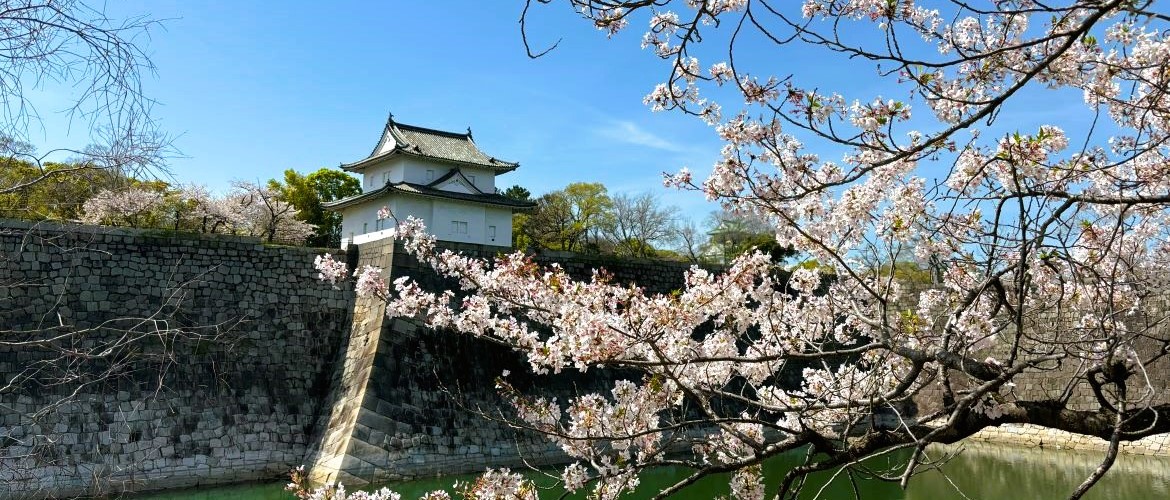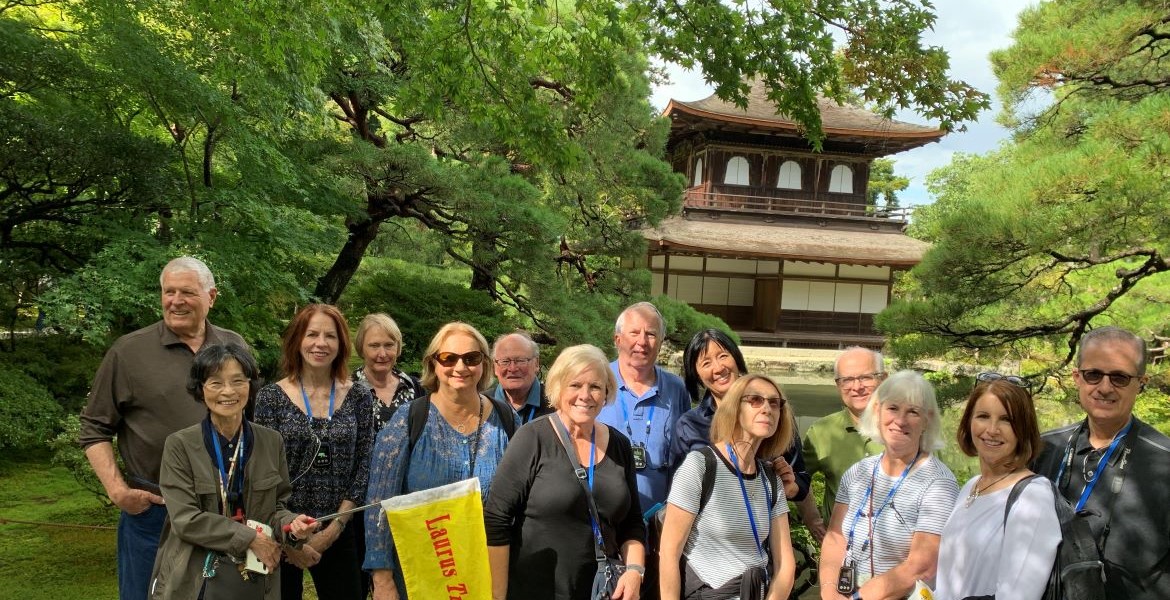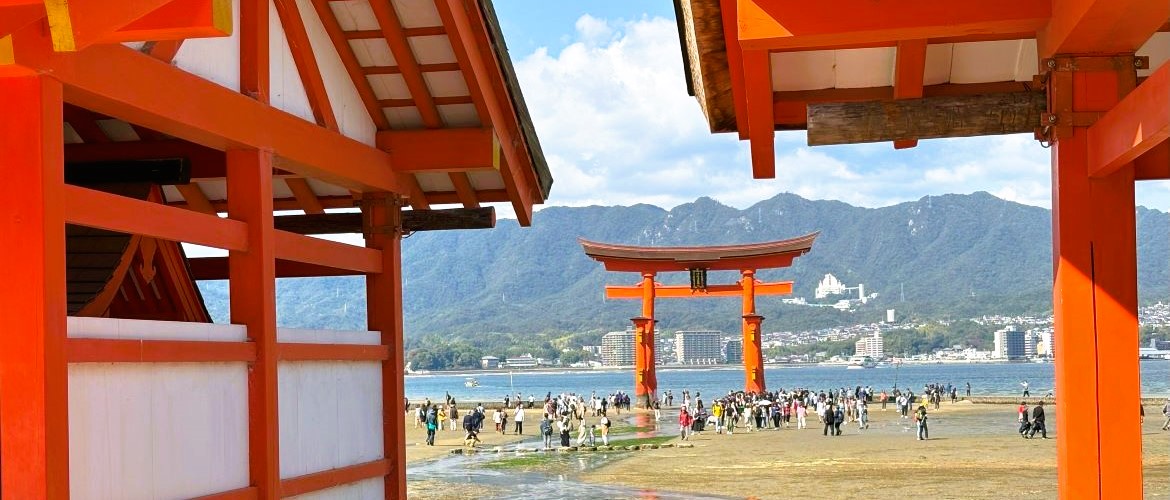Kyoto – Nara – Osaka – Hiroshima – Tokyo
This premium small-group tour ensures an intimate experience. Whether you’re a first-time visitor or a seasoned traveller, this journey promises to unveil the timeless allure of Japan, leaving you with memories to cherish for a lifetime.
Important Features
- Small group size (average 15, maximum 20)
- Expert professional guides
- No annoying shopping stops
- Immersive cultural activities
- Quality Japanese and Western cuisines
- Special dinners featuring maiko performance & premium wagyu beef
TOUR ITINERARY
Meal Code: B = breakfast / L = lunch / D = dinner
Day 1/Sat: Departing for Japan
The journey begins with your transpacific flight departing from a city of your choice. You’ll lose a day upon crossing the International Date Line.
Day 2/Sun: Arrival in Kyoto
Welcome to Kyoto!
Please make your way to the hotel on your own. Detailed up-to-date information on how to get to the hotel will be provided in the pre-trip update two weeks before departure.
Day 3/Mon: Kyoto (B/L/D)
Nicknamed “City of Ten Thousand Shrines”, Kyoto (literal translation: capital city) served as Japan’s capital for more than one thousand years before the imperial court moved to Tokyo in 1868 with the onset of the Meiji Restoration (1868 to 1912, a historical period associated with the emergence of Japan as a modernized nation). Kyoto is a scaled replica of the Chinese Tang Dynasty’s capital Chang’an, present-day Xi’an. The Tang Dynasty (618 – 907) was a golden era in Chinese history and a time when Japanese adoption of Chinese culture reached its peak. Kyoto today, with a population of 1.46 million, forms a major part of the Kyoto-Osaka-Kobe metropolitan area.
Free morning to recover from jet lag or explore on your own.
Our first stop after lunch is Kinkaku-ji (Temple of Golden Pavilion). This is a Zen Buddhist temple and one of 17 locations comprising the Historic Monuments of Ancient Kyoto World Heritage Site.
We then proceed to the Arashiyama (Storm Mountain) area where our sightseeing takes in Tenryu-ji Temple and the Bamboo Forest. Located on the western outskirts of Kyoto, Arashiyama is famous for its immense natural beauty as well as its historical and cultural prominence due to the large number of well-preserved ancient Buddhist temples.
Afterwards, we return to the hotel to freshen up before heading out for a traditional kaiseki dinner accompanied by the private performance of a dancing geisha known as maiko in Japanese.
Day 4/Tue: Kyoto (B)
This morning’s walking tour begins at the magnificent Higashi Hongan-ji, an 800-metre (15 minutes) walk from the hotel. Higashi Hongan-ji is a Buddhist temple whose name means “the Eastern Monastery of the Original Vow”. The temple was first established in 1602 by the shōgun Tokugawa Ieyasu when he split the Jodo Shinshu (True Pure Land), also known as Shin Buddhism, in two (Nishi Honganji being the other) in order to diminish its power.
At the center of the temple is the Founder’s Hall, where an image of the temple’s founder, Shinran, is enshrined. The hall is one of the largest wooden structures in the world at 76 m (250 ft.) in length, 58 m (190 ft.) in width, and 38 m (125 ft.) in height. The current hall was constructed in 1895 after it was burned down in 1864 during the Kinmon Incident.
We then take the subway (3 stops) to magnificent Nijo Castle. Construction of the castle began in 1601 under the order of Tokugawa Ieyasu, founder of the Tokugawa shogunate, but was not completed until 1626 during the reign of Iemitsu, the third Tokugawa shogun and grandson of Ieyasu. The Tokugawa shogunate was headquartered in Edo, present-day Tokyo, and Nijo Castle was the shogun’s residence in Kyoto where the imperial court was located. Nijo Castle is also the site that witnessed the ending of the Tokugawa shogunate. In late 1867, the last shogun, Yoshinobu, announced in the castle his decision to return his power back to the emperor. This was a watershed moment that helped usher in the Meiji Restoration, which, in turn, led to Japan’s industrialization and fundamentally transformed the Japanese society.
Afterwards, we return to the hotel by subway (3 stops) for a break.
The afternoon walking tour takes in the famous Gion district, the birthplace of the geisha culture. The 2-kilometre walk from the hotel is on flat ground and takes about 25 to 30 minutes.
Day 5/Wed: Kyoto (B)
Today is set aside for you to explore on your own.
Our recommendations include Kiyomizu-dera (Buddhist temple), Kyoto Imperial Palace, Fushimi Inari Shrine (good for hiking), Ginkaku-ji (Silver Pavilion Temple), and Kyoto National Museum.
Day 6/Thu: Kyoto – Nara – Osaka – Hiroshima (B/L)
We depart for Nara at 07:45. The 45-km drive to the magnificent Todai-ji temple takes about an hour. This ancient Buddhist temple is well-known not only for its splendid architecture and the huge bronze statue of the Buddha in the main hall but also for the 1,200 wild deer roaming freely on the grounds of the temple.
Nara is the capital city of Nara Prefecture and a former capital of Japan (710 – 794). With a population of roughly 370,000 and an area of 280 square kilometres, the city occupies the northern part of Nara Prefecture. Eight temples, shrines and ruins together with Kasugayama Primeval Forest collectively form “The Historic Monuments of Ancient Nara” – a UNESCO World Heritage Site.
Afterwards we continue on to Osaka, where we visit the historic Osaka Castle and Osaka’s legendary shopping and entertainment district known as Dotonbori. Situated at the mouth of the Yodo River on Osaka Bay, Osaka is Japan’s third most populous city (after Tokyo and Yokohama) and plays a significant role in the Japanese economy. Osaka was once known as the “nation’s kitchen” because of its function as Japan’s rice trading centre during the Edo period.
We then transfer to the Shin Osaka Station for the late afternoon rail journey to Hiroshima (Sakura 563, 16:23/17:51).
Day 7/Fri: Hiroshima – Miyajima – Hiroshima (B/D)
Hiroshima, literally meaning ‘broad island’, is the capital of Hiroshima Prefecture and the largest city in the Chugoku region with a population of 1.2 million. Hiroshima is best known as the first city in history to be targeted by a nuclear weapon when the United States Army Air Forces dropped an atomic bomb on the city (and later on Nagasaki) at 8:15 a.m. on August 6, 1945, near the end of World War II. The highlight in Hiroshima, understandably but sadly, is the Peace Memorial Park which includes the Peace Memorial Museum, and the Atomic Bomb Dome that once served as the industrial promotion hall of the local prefect.
After a tour of the Peace Memorial Park complex including two hours in the museum onsite, we proceed to Miyajima Island by a combination of taxi, commuter train and ferry.
Officially known as Itsukushima, Miyajima is a small island (30 square kilometres, population 1,760) in Hiroshima Bay known for its forests and ancient temples. The seaside Itsukushima Shinto Shrine on the island is a UNESCO World Heritage Site and the “floating” torii gate in front of the shrine is the main reason for most visitors to come here.
Day 8/Sat: Hiroshima – Tokyo (B)
The rail journey back to Tokyo this morning takes 3 hours 50 minutes (Nozomi 10, 09:07/12:57).
Transfer to the hotel on arrival and spend the balance of the day exploring on your own. Our recommendations include shopping at Ginza and Akihabara, which even non-shoppers would find exciting. Be sure to carry your passport with you. Merchandise purchases over 5,000 yen qualify for sales tax-exemption at many stores (this policy may change in 2025), but you’ll have to show your passport to claim it.
Day 9/Sun: Tokyo (B/L/D)
Tokyo, literally meaning “eastern capital” and officially named Tokyo Metropolis, is one of the most populous mega-cities in the world with a population of 14 million. Formerly known as Edo, the city has been the de facto seat of the Japanese government since 1603 when shogun Tokugawa Ieyasu chose the city for his headquarters. The shogun (general) was a hereditary commander ceremoniously appointed by the emperor but held real power over the country during the shogunate period between 1192 and 1867. Edo was renamed Tokyo after Emperor Meiji moved his seat from Kyoto in 1868 when the last shogun was forced to return power to the imperial court. The city covers an area of 2,187 square kilometres following the merger in 1943 of the city of Tokyo and Tokyo Prefecture.
Our full-day sightseeing begins at the plaza in front of the Imperial Palace. The palace is closed to tourists but a stroll across the plaza accompanied by commentaries on the imperial family and the city of Tokyo gets the tour off to a good start.
We then proceed to Senso-ji, the oldest Buddhist temple in Tokyo dating back to 628.
After lunch, we drive through ritzy Ginza shopping district on the way to Meiji Jingu, a Shinto shrine dedicated to Emperor Meiji (1852 -1912) and his wife.
We end the day with a visit to the observation deck atop the Tokyo Metropolitan Government Building in Shinjuku. On a clear day, the visitor could see the peak of Mount Fuji about 84 km to the west. The building complex completed in 1990 at a cost of US$1 billion consists of three main structures each taking up a city block. The architect of the Tokyo Metropolitan Government Building is Kenzo Tange (1913 – 2005), who in 1987 became the first Japanese to win the Pritzker Prize for Architecture.
Farewell dinner features premium Japanese beef (wagyu).
Day 10/Mon: Tokyo – Return Home (B)
The tour ends this morning. The Airport Limousine Bus is highly recommended for your transfer to the airport. The shuttle bus costs 3,600 yen (US$25) to Narita airport and 1,500 yen (US$11) to Haneda airport. Private transfer can also be arranged on request.
Hotel List
| City | Nights | Hotel | Category |
| Kyoto | 4 | Hilton Garden Inn Kyoto | Premium /4 stars |
| Hiroshima | 2 | Hotel Granvia Hiroshima | Premium /4 stars |
| Tokyo | 2 | Tokyo Dome Hotel | Premium /4 stars |
Dates and Prices
| Depart (Sat) |
Return (Mon) |
Land Only* CA$/US$ |
Single Supplement CA$/US$ |
| 2025 | |||
| 11-Oct | 20-Oct | $6,790/$4,850 | $2,520/$1,800 |
| 18-Oct | 27-Oct | $6,790/$4,850 | $2,520/$1,800 |
| 25-Oct | 03-Nov | $6,790/$4,850 | $2,520/$1,800 |
| 01-Nov | 10-Nov | $6,790/$4,850 | $2,520/$1,800 |
| 08-Nov | 17-Nov | $6,790/$4,850 | $2,520/$1,800 |
| 15-Nov | 24-Nov | $6,790/$4,850 | $2,520/$1,800 |
| 2026 | |||
| 04-Apr | 13-Apr | $6,930/$4,950 | $2,520/$1,800 |
| 11-Apr | 20-Apr | $6,790/$4,850 | $2,520/$1,800 |
| 18-Apr | 27-Apr | $6,790/$4,850 | $2,520/$1,800 |
| 16-May | 25-May | $6,580/$4,700 | $2,520/$1,800 |
| 23-May | 01-Jun | $6,580/$4,700 | $2,520/$1,800 |
* Land Only price does not include international airfare. Contact us for a fare quote.
|
Tour price includes:
|
Tour price does NOT include:
See Terms & Conditions for more information. |
Passport & Visa
Your passport must have at least one blank visa page and be valid at the end of the tour.
If you are a tourist from Canada, the US, the UK, Australia and New Zealand, you do not need a visa to enter Japan as long as your stay is within 90 days.
Vaccination
No vaccination of any kind is mandatory. Vaccination against hepatitis A is highly recommended.




